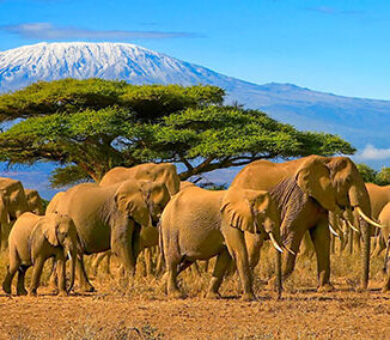East Africa certainly isn’t short on wildlife spectacles, but elephant migrations remain among the most powerful and memorable of them all. African elephants are highly intelligent, social animals, and watching their herds move across untouched landscapes is an experience that stays with you long after you return home.
The key to a truly authentic elephant encounter is knowing how to get close to these giants without disturbing their rhythm. As such, if you’re planning an elephant safari, timing and location are absolutely crucial.
To help you prepare for the trip of a lifetime, here’s our guide to some of the most notable elephant migration spots in East Africa and when to go to see them in all

The Tsavo Ecosystem, stretching across Tsavo East and Tsavo West National Parks, is one of Kenya’s last remaining strongholds for African elephants. What makes Tsavo special is not just the number of elephants, although it does have the largest population in Kenya, but the sheer scale of it. Elephants migrate across the sprawling landscape decorated with baobabs, red dust plains, and dramatic ancient lava flows.
During the dry season, especially from June to October, water becomes scarce here. This means elephants start grouping around permanent water sources, particularly along the Galana River in Tsavo East. This movement isn’t quite as sharply defined as the wildebeest migration but with patience and a good guide, you can track family herds as they travel across the landscape.
To get a full view of this migration, we’d recommend combining Tsavo East and West, especially with the addition of guided bush walks to get even deeper access to these magnificent animals.
The Serengeti is world famous for its lion prides and huge herds of wildebeest. What isn’t as widely known is that African elephants quietly make their own journeys across the same region, particularly through the lesser-walked woodlands and river valleys of northern Serengeti and the adjacent Loliondo and Maswa areas.
Between November and March, after the short rains, elephants move into the greener areas around the Grumeti and Mara rivers. The vegetation is richer, water is easier to find and family groups spread out across the corridor which connects Kenya’s Masai Mara and Tanzania’s Serengeti. You won’t find elephants marching neatly in single-file, but you will see constant activity with groups foraging, bathing, and communicating – all of which makes for great safari photography.
For serious elephant safari travelers, this is the time to head off the main tracks. ARP Africa can arrange tailormade trips to some of these lesser-known elephant hotspots, giving you a truly unique experience to remember.
North of Mount Kenya, the Isiolo Corridor is a big part of a elephant pathway linking Laikipia to the Samburu and Marsabit ecosystems. This area is home to a wide range of community conservation efforts, with many conservancies playing crucial roles in protecting the corridor.
Elephants move through this region during both the short dry season (Jan-Mar) and the long dry season (July-August), following their instincts to forage and find water. Because of the tight cooperation between communities and conservationists, it’s now one of the best places in East Africa to see elephants.
Don’t expect a mass migration, but rather a quiet flow of elephants across valleys and ridgelines, sometimes crossing roads, villages, or riverbeds.
The Selous-Niassa wildlife corridor is one of Africa’s largest, linking the Selous Game Reserve (now part of Nyerere National Park) to northern Mozambique. Elephants use this corridor to move between dry and wet season habitats, though security issues and habitat loss have made this migration a little harder to witness in person.
That said, Tarangire National Park offers a more accessible elephant safari experience tied to this broader movement. From July through October, during the dry season, Tarangire becomes a magnet for elephants from surrounding conservancies and the Lake Manyara basin. It’s not unusual to see hundreds of elephants gathered near the Tarangire River – one of the few permanent water sources in the region.
Murchison Falls National Park, in northern Uganda, might not be the first place many think of for elephant migrations, but it’s a true lesser-known gem. The elephants here follow a pretty strict seasonal pattern, moving between the northern savannas and the forests near the Victoria Nile and Karuma Falls.
During the dry seasons (Dec-Feb and Jun-Sep), elephants gather in higher numbers around the Nile, making for fantastic viewing. Their movement through the park is influenced by both water and security, with restored wildlife corridors now reconnecting ranges which have been fragmented by years of conflict and poaching.
For travelers seeking a less conventional elephant safari, Murchison offers both boat and land-based tracking, often in dramatic settings with waterfalls, majestic plains and tropical forests.
Elephant migrations in East Africa aren’t the dramatic stampedes of the Serengeti wildebeest, but they are no less awe-inspiring. These migrations are the embodiment of animal instinct, endurance, and deep ecological knowledge passed down through generations.
Planning around these movements makes all the difference. Whether you’re viewiing in Tsavo, Tarangire or Murchison, each spot offers a different perspective on the unforgettable African wilderness.
At ARP Africa, we work with local experts and tour guides to bring together the perfect elephant migration itineraries for you. If you’re looking to build lifelong memories courtesy of these stunning giants, get in touch with us and we’ll help make it happen.
